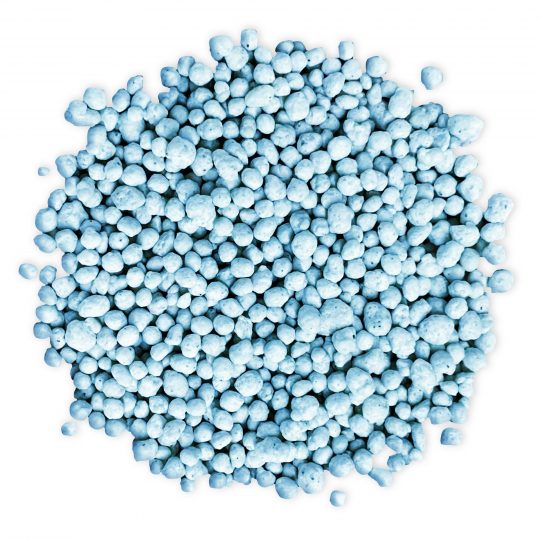Inhibited Urea+ (Urea+)

Technical specification
Urea+ is a one-component nitrogen fertilizer that is high in nitrogen – 46%. The fertilizer is treated with 0.144% of urease inhibitor as an active ingredient. When adding compounds that inhibit (suppress) the synthesis of urease enzyme by urea bacteria found in soils, urea converts into ammonia, carbon dioxide and water. The fertilizer application enhances crop vigor and stimulates root system strengthening and development.
The urease inhibitor:
- Reduces nitrogen loss;
- Retards the conversion of urea into ammonium;
- Provides more time for the urea molecule to be absorbed in the soil through precipitation;
- Leads to a lower concentration of NH4+and NH3 near the seeds.
When urea with no inhibitor interacts with soil, enzymatic degradation processes occur under the action of urease enzyme (pH 6.4–6.9) released by soil bacteria. These processes lead to an increase in soil pH and loss of NH3. In this case, the hydrolysis process is accelerated, which results in evaporation of NH3/NH4+.
Amounts of nitrogen lost as NH3 vary depending on soil and environmental conditions: they are higher when urea is applied on the surface of light soils at high temperatures and high moisture.
By slowing down the rate of urea hydrolysis in the soil, urease inhibitors decrease gaseous nitrogen losses and the ammonium ion concentration in the soil solution. This reduces the risk of adverse effects on sprouts at higher doses of urea applied as pre-sowing fertilization.
Urease inhibitors slow down the process of urea hydrolysis and enable plants to absorb nitrogen over a longer period of time. Nitrogen efficiency is increased and environmental protection is promoted by using inhibited urea.
The ecological importance of this product is as follows:
- Ensures an even supply of nitrogen to plants;
- Reduces the risk of nitrogen loss and increases bioavailability;
- The chlorophyll content and transpiration rate are higher in the plants treated with urea supplemented with urease inhibitor.
- Lowers fertilization costs by reducing the number of nitrogen fertilizer applications.
Advantages
- Urea+ is specially formulated to reduce ammonia volatilization and ensure more nitrogen for plant nutrition. At the same time, this fertilizer allows greater flexibility for selecting fertilization time. It serves as a source of nutrients and stimulates plant growth and resistance by improving the soil general condition.
- Urea+ provides the necessary amount of nitrogen and its use, at a reduced fertilizer dose, saves time and labor. In addition, it allows to extend the period of urea application, gives more freedom to work at higher temperatures (20–25°C) and provides flexibility in farmers’ work.
- The nitrogen protection technology allows maximum flexibility for selecting fertilization time and a smaller environmental footprint due to reduced ammonia volatilization.
- The inhibitor molecules are biodegradable so they only have an effect during the period of use, but this also shortens their shelf life, which is up to 6 months and depends on the dose and time of treatment. It is therefore important to work with manufacturers who can supply the product treated shortly before its date of use.
Packing
- Big begs - 1100 kg
Customs tariff number
3102101000
Instructions for use: FOR PROFESSIONAL AND CONSUMER USE!
| Crop | Application period | Application dose | Application technique |
| Cereals | During winter dormancy, in January through February | 100 to 250 kg/ha | Surface application with a fertilizer spreader |
| Sunflower | In spring – prior to sowing | 150 to 200 kg/ha | Surface application with a fertilizer spreader before the last cultivation or by using a fertilizer feeder during sowing |
| Perennials | During the growing season or shortly before the beginning of such | 100 to 150 kg/ha | Application with a fertilizer spreader for perennial plants or by using an irrigation system |
| Vegetable crops | Before sowing or before transplanting the seedlings | 200 to 300 kg/ha | Surface application before the last cultivation |
| Lawn areas | Before the start of spring growth and after each cutting | 10 to 20 g/m2 | Surface application by using appropriate equipment; watering after application is required. |
These are the recommended doses for product application. Farmers are advised to seek counsel from a consultant in order to adapt the recommended doses to their specific conditions and avoid over-fertilisation.
Storage life: 12 months after the date of manufacture.
Storage environment: dry, well-ventilated area protected from direct sunlight
Storage conditions: without large temperature variations, at temperature up to 300C
Arrangement in piles: The pile arrangement maximum size must comply with the national requirements. Provide spacing between the pile arrangements for quick access. Do not store with incompatible products.
Incompatible materials: Strong oxidizing agents, acids, bases, nitrates, nitrites, sodium or calcium hypochlorite. Mixing solid urea with solid ammonium nitrate results in the formation of a blend. Urea reacts with sodium or calcium hypochlorite to produce explosive nitrogen trichloride.